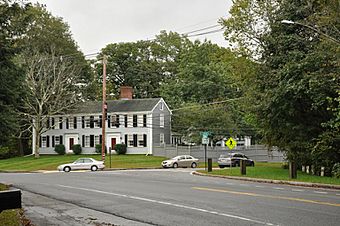Kendal Green Historic District facts for kids
Quick facts for kids |
|
|
Kendal Green Historic District
|
|

The corner of North and Church Streets
|
|
| Location | Weston, Massachusetts |
|---|---|
| Architectural style | Colonial, Federal |
| NRHP reference No. | 01000121 |
| Added to NRHP | March 1, 2000 |
The Kendal Green Historic District is a special area in Weston, Massachusetts. It runs along North Avenue, which is also known as Massachusetts Route 117. This historic district is about three-quarters of a mile long. It shows how Weston changed from a farming town to a place where people live and commute to Boston. The district has many old homes and farm buildings. It also includes two spots where factories used to be. These factories were important to Weston's past. The Kendal Green Historic District was added to the National Register of Historic Places in 2000.
Contents
Exploring Kendal Green
North Avenue is a main road in northeastern Weston. It has been around since colonial times. Today, it connects Waltham to Maynard. A train line, the Fitchburg Railroad, runs south of North Avenue. This line is now used by the MBTA for commuter trains. There is a train stop called Kendal Green on Church Street, just south of North Avenue.
What the District Includes
The historic district stretches along North Avenue. It goes from Hobbs Brook Road in the east to Viles Street in the west. The Hastings train station is located at the western end. Most of the old buildings are on North Avenue. The district also includes part of Church Street, where the historic train station building is. A small industrial area on Viles Street and Brooks Road is also part of the district.
History of Kendal Green
The Weston area was first settled in the 1600s. Back then, it was part of Watertown. North Avenue was one of the first places where people built homes. The oldest building in the district is the Whitney Tavern at 171 North Avenue. It was built around 1707.
The Hobbs Family and Their Tannery
In 1729, a man named Josiah Hobbs bought a lot of land in this area. A brook, Hobbs Brook, is named after his family. Josiah Hobbs also got the right to use water from the brook. He used this water to run a tannery. A tannery is a place where animal hides are turned into leather. This was one of the first industries in the Massachusetts Bay Colony. Five generations of the Hobbs family ran the tannery for over 100 years. They also built several homes that are still standing today. These include houses at 87, 88, and 121 North Avenue. The house at 87 North Avenue, called the Isaac Hobbs House, is so important that it is listed separately on the National Register.
The Railroad and Organ Factory
The railroad line was built through this area in the 1840s. It runs along the southern edge of the historic district. At first, the railroad did not change the area much. But in the 1880s, something big happened. The E. and G.G. Hook and Hastings Organ Company built a factory on Viles Street, right by the railroad.
This organ factory became the biggest employer in Weston. It was very important for the town's growth. The factory buildings themselves are no longer there. However, many houses on North, Viles, and Brooks Streets were built because of the factory. These homes were built either by the company or by others to house its workers.



